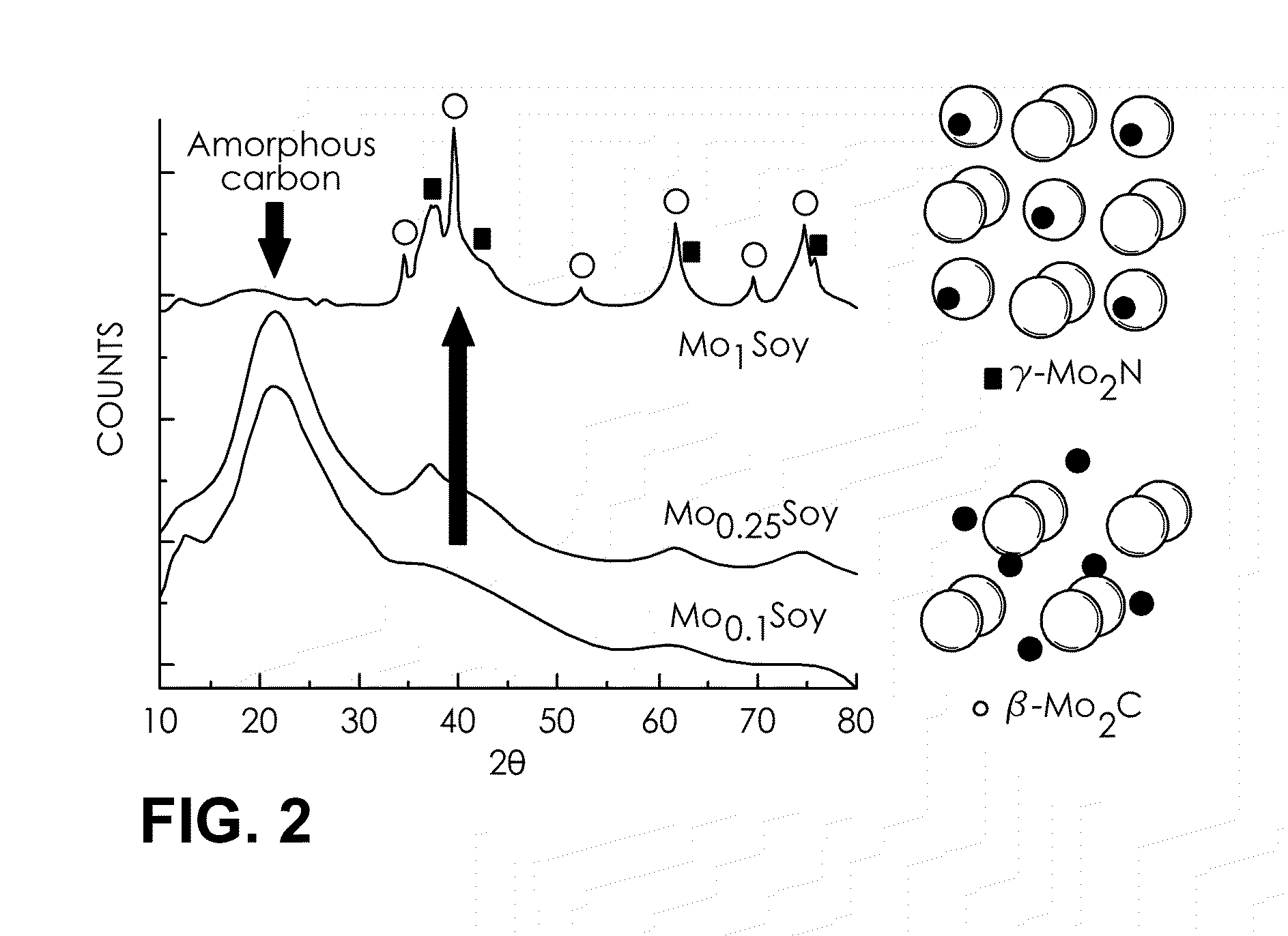Biomass transition metal hydrogen-evolution electrocatalysts and electrodes
a transition metal and electrocatalyst technology, applied in the field of biomass transition metal hydrogenevolution electrocatalysts and electrodes, can solve the problems of high cost of platinum, impediment in use, and difficult hydrogen evolution reaction (her) in acidic condition,
- Summary
- Abstract
- Description
- Claims
- Application Information
AI Technical Summary
Benefits of technology
Problems solved by technology
Method used
Image
Examples
example 1
Preparation of Catalytic Compositions
[0064]Dry, organic soybeans were purchased from a supplier of organic foods (Whole Foods Market) and were ground to a powder. The powdered soybean (biomass) and ammonium molybdate ((NH4)6Mo7O24.4H2O) were suspended together in water using a variety of weight ratios of the biomass to the Mo salt, as shown in FIGS. 2 and 3. The suspensions were sonicated and then dried at 80° C. for 5 to 10 hours. The dried materials were calcined at 800° C. under argon in a tube furnace. Dark grey powder catalytic compositions (MoxSoy, x: weight ratio of Mo salt to soybean powder) were obtained. These catalytic compositions may be stored for later use.
[0065]The labeling on the soybeans packages used for this work reported that the soybeans contained about 12 g of protein for each 30 g of soybean—roughly a 40% protein composition.
example 2
Coating on a Surface
[0066]For coating MoxSoy on a surface or substrate, the coating takes place before the calcination. Taking carbon paper as an example, the suspension (raw soybean powder and ammonium molybdate in water) was applied directly onto the paper, and dried in an oven at 80° C. for 1 h. Then the coated paper was placed in a quartz tube furnace and was calcined at 800° C. for 2 hours under argon. The same procedure was carried out on carbon cloths, stainless steel meshes and Si wafers.
example 3
Evaluation of MoxSoy electrodes
[0067]To evaluate hydrogen evolution reaction (HER) performance, a series of MoxSoy catalyst carbon paper “electrodes” (x=0.1, 0.25, and 1)was exposed to H2-saturated 0.1M HClO4 solution in a standard three-electrode electrochemical cell at room temperature. FIG. 1 reports the current densities obtained during a linear sweep voltammetry experiment of the MoxSoy catalysts (catalyst loading: 8 mg cm−2) coated on a carbon paper (Toray TGP-H-060). A reductive process is observed as the voltage is applied below −0.05 V for the Mo1Soy catalyst. Hydrogen bubbles evolved more vigorously on the electrode having MoxSoy with higher values of x. As a control experiment, a commercial Pt / C catalyst (E-TEK 20 wt % Pt / XC-72), a bulk Pt disk and a Mo metal disk were also examined. The Pt / C catalyst exhibited high HER catalytic performance with a small overvoltage (7710, defined as the voltage at 10 mA cm−2 of cathodic current density) of 75 mV. As a point of reference ...
PUM
| Property | Measurement | Unit |
|---|---|---|
| grain size | aaaaa | aaaaa |
| grain size | aaaaa | aaaaa |
| pore size | aaaaa | aaaaa |
Abstract
Description
Claims
Application Information
 Login to View More
Login to View More - R&D
- Intellectual Property
- Life Sciences
- Materials
- Tech Scout
- Unparalleled Data Quality
- Higher Quality Content
- 60% Fewer Hallucinations
Browse by: Latest US Patents, China's latest patents, Technical Efficacy Thesaurus, Application Domain, Technology Topic, Popular Technical Reports.
© 2025 PatSnap. All rights reserved.Legal|Privacy policy|Modern Slavery Act Transparency Statement|Sitemap|About US| Contact US: help@patsnap.com



